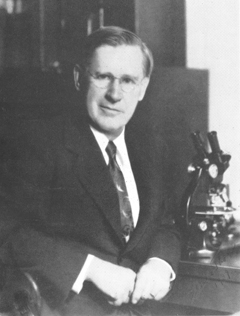
Penicillium is a genus of ascomycetous fungi that is part of the mycobiome of many species and is of major importance in the natural environment, in food spoilage, and in food and drug production.

Penicillium roqueforti is a common saprotrophic fungus in the genus Penicillium. Widespread in nature, it can be isolated from soil, decaying organic matter, and plants.
Mycotoxicology is the branch of mycology that focuses on analyzing and studying the toxins produced by fungi, known as mycotoxins. In the food industry it is important to adopt measures that keep mycotoxin levels as low as practicable, especially those that are heat-stable. These chemical compounds are the result of secondary metabolism initiated in response to specific developmental or environmental signals. This includes biological stress from the environment, such as lower nutrients or competition for those available. Under this secondary path the fungus produces a wide array of compounds in order to gain some level of advantage, such as incrementing the efficiency of metabolic processes to gain more energy from less food, or attacking other microorganisms and being able to use their remains as a food source.

Charles Thom was an American microbiologist and mycologist. Born and raised in Illinois, he received his PhD from the University of Missouri, the first such degree awarded by that institution. He studied the microbiology of dairy products and soil fungi, and in particular researched the genera Aspergillus and Penicillium. His work influenced the establishment of standards for food handling and processing in the USA. He pioneered the use of culture media to grow microorganisms, and, with food chemist James N. Currie, developed a process to mass-produce citric acid using Aspergillus. Thom played an important role in the development of penicillin in World War II.
Penicillium adametzii is an anamorph fungus species of the genus of Penicillium.
Penicillium citrinum is an anamorph, mesophilic fungus species of the genus of Penicillium which produces tanzawaic acid A-D, ACC, Mevastatin, Quinocitrinine A, Quinocitrinine B, and nephrotoxic citrinin. Penicillium citrinum is often found on moldy citrus fruits and occasionally it occurs in tropical spices and cereals. This Penicillium species also causes mortality for the mosquito Culex quinquefasciatus. Because of its mesophilic character, Penicillium citrinum occurs worldwide. The first statin (Mevastatin) was 1970 isolated from this species.
Penicillium coffeae is a fungus species of the genus of Penicillium which was isolated from the plant Coffea arabica L. in Hawaii. Insects play a role in spreading Penicillium coffeae.
Penicillium decumbens is an anamorph species of the genus of Penicillium which occurs widespread in nature, mainly in subtropical and tropical soil but it also occur in food. Analysis have shown that Penicillium decumbens has antibiotic activity Penicillium decumbens produces the cyclopentenone cyclopenicillone
Penicillium georgiense is a species of the genus of Penicillium which was isolated from soil of a sandy beach from the Batu Ferringhi beach on the Penang Island in Malaysia and it was also isolated soil of a peanut field in Georgia in the United States.
Penicillium gladioli is a species of the genus of Penicillium which occurs on corms of the plant Gladiolus debtis. Penicillium gladioli produces gladiolic acid and patulin.
Penicillium herquei is an anamorph, filamentous species of the genus of Penicillium which produces citreorosein, emodin, hualyzin, herquline B, janthinone, citrinin and duclauxin,.
A species of the genus of Penicillium which causes Blue Mold of Garlic on Allium sativum L. The genus name is derived from the Latin root penicillum, meaning "painter's brush", and refers to the chains of conidia this fungus produces that resemble a broom.
Penicillium macrosclerotiorum is a species of the genus Penicillium, which was isolated from soil in south China.
Penicillium miczynskii is a species of the genus Penicillium which was isolated from soil under conifers in Poland. Penicillium miczynskii produces citreoviridin.
Penicillium nodositatum is an anamorph, biverticillate species of the genus Penicillium which induce the growth of the myconodules in the species Alnus incana.
Penicillium oxalicum is an anamorph species of the genus Penicillium which was isolated from rhizosphere soil of pearl millet. Penicillium oxalicum produces secalonic acid D, chitinase, oxalic acid, oxaline and β-N-acetylglucosaminidase and occurs widespread in food and tropical commodities. This fungus could be used against soilborne diseases like downy mildew of tomatoes
Penicillium simplicissimum is an anamorph species of fungus in the genus Penicillium which can promote plant growth. This species occurs on food and its primary habitat is in decaying vegetations Penicillium simplicissimum produces verruculogene, fumitremorgene B, penicillic acid, viridicatumtoxin, decarestrictine G, decarestrictine L, decarestrictine H, decarestrictine I, decarestrictine K decarestrictine M, dihydrovermistatin, vermistatin and penisimplicissin

Penicillium digitatum is a mesophilic fungus found in the soil of citrus-producing areas. It is a major source of post-harvest decay in fruits and is responsible for the widespread post-harvest disease in Citrus fruit known as green rot or green mould. In nature, this necrotrophic wound pathogen grows in filaments and reproduces asexually through the production of conidiophores and conidia. However, P. digitatum can also be cultivated in the laboratory setting. Alongside its pathogenic life cycle, P. digitatum is also involved in other human, animal and plant interactions and is currently being used in the production of immunologically based mycological detection assays for the food industry.
Penicillium zonatum is an anamorph species of fungus in the genus Penicillium which was isolated from soil. Penicillium zonatum produces xanthomegin, brefeldin A and janthitrem B



